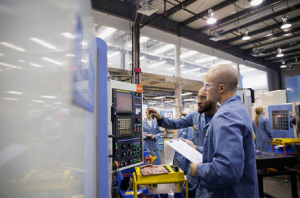(Akiit.com) When most people think of manufacturing, they imagine a dirty sector, churning out pollution and destroying the planet. And while that remains true of a select few industries, like petrochemicals and oil and gas, it’s no longer valid for the millions of other manufacturing activities going on all over the world. Manufacturing isn’t the dangerous, environmentally-damaging thing that it once was, but rather something that helps to create products sustainably for people around the globe.
Take a look on the inside of practically any modern factory, and you’ll see something surprising: the cleanliness. Workers don’t choke in soot-filled rooms anymore, wrestling with machinery. Instead, trained engineers sit behind computer consoles monitoring  equipment to make sure that everything is running smoothly. Companies can’t afford to be dirty: workers and customers just wouldn’t put up with it. They’ve had to adapt, and it’s made a big difference to everybody involved.
equipment to make sure that everything is running smoothly. Companies can’t afford to be dirty: workers and customers just wouldn’t put up with it. They’ve had to adapt, and it’s made a big difference to everybody involved.
Cleanliness inside production facilities began in earnest in the 1980s when chip manufacturers realized that they needed to prevent dust from getting onto silicon wafers. Dust contamination could ruin the deposition process and make processors unusable, and so companies like Intel invested large amounts of capital in making sure that their clean rooms were spotless. Since then, product quality demands have necessitated cleanliness at every stage. Take a look at Tesla’s car manufacturing facility in Fremont. It looks more like an operating theatre than a factory floor.
Advanced Manufacturing
Thanks to companies like Mills CNC, manufacturing is becoming a lot more computerized and precise. Prototypes already exist for the automated production of some clothing garments which could potentially disrupt millions of people in sweatshops in emerging markets. But more than that, experts predict that the biological sciences, chemistry, and nanotechnology will force significant changes in the sector, changing the face of modern manufacturing forever from its old stereotype.
The loss of manufacturing jobs will be bad for some workers, but many other people will gain. Consumers, for instance, will be able to buy more physical products with each dollar they earn, and owners of manufacturing firms should be able to reap higher profits.
Hopefully, more positive stories will emerge in the media too, highlighting the many societal benefits that come from clean and efficient manufacturing. With fewer people employed in the sector, the risk of people getting injured at work should decline. And wages should rise too since people will need to be more skilled to operate equipment and design production flows.
Where all this is going remains to be seen. But the fourth industrial revolution will demand increasing integration with artificial intelligence and the cloud. Ideally, factories would run themselves eliminating wage costs and reducing the price of goods for everybody, just as mass production did in the 1930s and 1940s. Ultimately, this might help deal with the problem of an aging population. With fewer people in work, manufacturing needs to reduce the number of people it employs while keeping production high. Only then will there be enough goods to go around.
Staff Writer; Larry Love









Leave a Reply